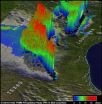(Press-News.org) Earth is clingy when it comes to copper. A new Rice University study this week in the journal Science finds that nature conspires at scales both large and small -- from the realms of tectonic plates down to molecular bonds -- to keep most of Earth's copper buried dozens of miles below ground.
"Everything throughout history shows us that Earth does not want to give up its copper to the continental crust," said Rice geochemist Cin-Ty Lee, the lead author of the study. "Both the building blocks for continents and the continental crust itself, dating back as much as 3 billion years, are highly depleted in copper."
Finding copper is more than an academic exercise. With global demand for electronics growing rapidly, some studies have estimated the world's demand for copper could exceed supply in as little as six years. The new study could help, because it suggests where undiscovered caches of copper might lie.
But the copper clues were just a happy accident.
"We didn't go into this looking for copper," Lee said. "We were originally interested in how continents form and more specifically in the oxidation state of volcanoes."
Earth scientists have long debated whether an oxygen-rich atmosphere might be required for continent formation. The idea stems from the fact that Earth may not have had many continents for at least the first billion years of its existence and that Earth's continents may have begun forming around the time that oxygen became a significant component of the atmosphere.
In their search for answers, Lee and colleagues set out to examine Earth's arc magmas -- the molten building blocks for continents. Arc magmas get their start deep in the planet in areas called subduction zones, where one of Earth's tectonic plates slides beneath another. When plates subduct, two things happen. First, they bring oxidized crust and sediments from Earth's surface into the mantle. Second, the subducting plate drives a return flow of hot mantle upwards from Earth's deep interior. During this return flow, the hot mantle not only melts itself but may also cause melting of the recycled sediments. Arc magmas are thought to form under these conditions, so if oxygen were required for continental crust formation, it would mostly likely come from these recycled segments.
"If oxidized materials are necessary for generating such melts, we should see evidence of it all the way from where the arc magmas form to the point where the new continent-building material is released from arc volcanoes," Lee said.
Lee and colleagues examined xenoliths, rocks that formed deep inside Earth and were carried up to the surface in volcanic eruptions. Specifically, they studied garnet pyroxenite xenoliths thought to represent the first crystallized products of arc magmas from the deep roots of an arc some 50 kilometers below Earth's surface. Rather than finding evidence of oxidation, they found sulfides -- minerals that contain reduced forms of sulfur bonded to metals like copper, nickel and iron. If conditions were highly oxidizing, Lee said, these sulfide minerals would be destabilized and allow these elements, particularly copper, to bond with oxygen.
Because sulfides are also heavy and dense, they tend to sink and get left behind in the deep parts of arc systems, like a blob of dense material that stays at the bottom of a lava lamp while less dense material rises to the top.
"This explains why copper deposits, in general, are so rare," Lee said. "The Earth wants to hold it deep and not give it up."
Lee said deciding where to look for undiscovered copper deposits requires an understanding of the conditions needed to overcome the forces that conspire to keep it deep inside the planet.
"As a continental arc matures, the copper-rich sulfides are trapped deep and accumulate," he said. "But if the continental arc grows thicker over time, the accumulated copper-bearing sulfides are driven to deeper depths where the higher temperatures can re-melt these copper-rich dregs, releasing them to rejoin arc magmas."
These conditions were met in the Andes Mountains and in western North America. He said other potential sources of undiscovered copper include Siberia, northern China, Mongolia and parts of Australia.
Lee noted that a high school intern played a role in the research paper. Daphne Jin, now a freshman at the University of Chicago, made her contribution to the research as a high school intern from Clements High School in the Houston suburb of Sugarland.
"The paper really wouldn't have been as broad without Daphne's contribution," Lee said. "I originally struggled with an assignment for her because I didn't and still don't have large projects where a student can just fit in. I try to make sure every student has a chance to do something new, but often I just run out of ideas."
Lee eventually asked Jin to compile information from published studies about the average concentration of all the first-row of transition elements in the periodic table in various samples of continental crust and mantle collected the world over.
"She came back and showed me the results, and we could see that the average continental crust itself, which has been built over 3 billion years of Earth's history in Africa, Siberia, North America, South America, etc., was all depleted in copper," Lee said. "Up to that point we'd been looking at the building blocks of continents, but this showed us that the continents themselves followed the same pattern. It was all internally consistent."
###
In addition to Jin, Lee's co-authors on the report include Rajdeep Dasgupta, assistant professor of Earth science at Rice; Rice postdoctoral researchers Peter Luffi and Veronique Roux; Rice graduate student Emily Chin; visiting graduate student Romain Bouchet of the École Normale Supérieure in Lyon, France; Douglas Morton, professor of geology at the University of California, Riverside; and Qing-zhu Yin, professor of geology at the University of California, Davis.
The research was funded by the National Science Foundation.
High-resolution images are available for download at:
http://news.rice.edu/wp-content/uploads/2012/04/0405_COPPER.jpg
CAPTION: This garnet pyroxenite xenolith from Sierra Nevada, Calif., is an example of the deepest products of crystallization within the magmatic belts of subduction zones. Rice University's Cin-Ty Lee and colleagues showed that most of the copper in arc magmas eventually end up in these deep-seated rocks.
CREDIT: Cin-Ty Lee/Rice University
http://news.rice.edu/wp-content/uploads/2012/04/0406_COPPER_Lee2.jpg
CAPTION: Cin-Ty Lee
CREDIT: Jeff Fitlow/Rice University
Located on a 300-acre forested campus in Houston, Rice University is consistently ranked among the nation's top 20 universities by U.S. News & World Report. Rice has highly respected schools of Architecture, Business, Continuing Studies, Engineering, Humanities, Music, Natural Sciences and Social Sciences and is known for its "unconventional wisdom." With 3,708 undergraduates and 2,374 graduate students, Rice's undergraduate student-to-faculty ratio is 6-to-1. Its residential college system builds close-knit communities and lifelong friendships, just one reason why Rice has been ranked No. 1 for best quality of life multiple times by the Princeton Review and No. 4 for "best value" among private universities by Kiplinger's Personal Finance. To read "What they're saying about Rice," go to www.rice.edu/nationalmedia/Rice.pdf.
Copper chains: Study reveals Earth's deep-seated hold on copper
Study of copper's behavior in arc magmas yields clues about potential location of new finds
2012-04-10
ELSE PRESS RELEASES FROM THIS DATE:
Big advance against cystic fibrosis
2012-04-10
Harvard stem cell researchers at Massachusetts General Hospital (MGH) have taken a critical step in making possible the discovery in the relatively near future of a drug to control cystic fibrosis (CF), a fatal lung disease that claims about 500 lives each year, with 1,000 new cases diagnosed annually.
Beginning with the skin cells of patients with CF, Jayaraj Rajagopal, MD, and colleagues first created induced pluripotent stem (iPS) cells, and then used those cells to create human disease-specific functioning lung epithelium, the tissue that lines the airways and is ...
Scientists discover new threat to birds posed by invasive pythons
2012-04-10
Smithsonian scientists and their colleagues have uncovered a new threat posed by invasive Burmese pythons in Florida and the Everglades: The snakes are not only eating the area's birds, but also the birds' eggs straight from the nest. The results of this research add a new challenge to the area's already heavily taxed native wildlife. The team's findings are published in the online journal Reptiles & Amphibians: Conservation and Natural History.
Burmese pythons, native to southern Asia, have taken up a comfortable residence in the state of Florida, especially in the Everglades. ...
Study reveals impact of socioeconomic factors on the racial gap in life expectancy
2012-04-10
Differences in factors such as income, education and marital status could contribute overwhelmingly to the gap in life expectancy between blacks and whites in the United States, according to one of the first studies to put a number on how much of the divide can be attributed to disparities in socioeconomic characteristics.
A Princeton University study recently published in the journal Demography reveals that socioeconomic differences can account for 80 percent of the life-expectancy divide between black and white men, and for 70 percent of the imbalance between black ...
Researchers discover unique suspension technique for large-scale stem cell production
2012-04-10
Post-doctoral researcher David Fluri and Professor Peter Zandstra at the University of Toronto's Institute of Biomaterials and Biomedical Engineering (IBBME) have developed a unique new technique for growing stem cells that may make possible cost-effective, large-scale stem cell manufacturing and research.
Although stem cells are widely used for the testing of new drugs, researchers have always faced difficulties manufacturing enough viable cells from a culture. Typically, stem cells are grown on surfaces that must be scraped, and which must then be differentiated from ...
NASA's TRMM Satellite sees tornadic Texas storms in 3-D
2012-04-10
NASA's Tropical Rainfall Measuring Mission (TRMM) satellite provides a look at thunderstorms in three dimensions and shows scientists the heights of the thunderclouds and the rainfall rates coming from them, both of which indicate severity.
Powerful thunderstorms that created severe weather were more than 8 miles high.
NOAA's National Weather Service Storm Prediction Center received 18 reports of tornadoes occurring on April 3 over northeastern Texas. Some of these very destructive storms dropped softball sized hail as they passed to the south of the Dallas/Fort ...
Women cannot rewind the 'biological clock'
2012-04-10
Many women do not fully appreciate the consequences of delaying motherhood, and expect that assisted reproductive technologies can reverse their aged ovarian function, Yale researchers reported in a study published in a recent issue of Fertility and Sterility.
"There is an alarming misconception about fertility among women," said Pasquale Patrizio, M.D., professor in the Department of Obstetrics & Gynecology at Yale School of Medicine and director of the Yale Fertility Center. "We also found a lack of knowledge about steps women can take early in their reproductive ...
Salk scientists redraw the blueprint of the body's biological clock
2012-04-10
La Jolla, CA----The discovery of a major gear in the biological clock that tells the body when to sleep and metabolize food may lead to new drugs to treat sleep problems and metabolic disorders, including diabetes.
Scientists at the Salk Institute for Biological Studies, led by Ronald M. Evans, a professor in Salk's Gene Expression Laboratory, showed that two cellular switches found on the nucleus of mouse cells, known as REV-ERBα and REV-ERBβ, are essential for maintaining normal sleeping and eating cycles and for metabolism of nutrients from food.
The findings, ...
Which plants will survive droughts, climate change?
2012-04-10
New research by UCLA life scientists could lead to predictions of which plant species will escape extinction from climate change.
Droughts are worsening around the world, posing a great challenge to plants in all ecosystems, said Lawren Sack, a UCLA professor of ecology and evolutionary biology and senior author of the research. Scientists have debated for more than a century how to predict which species are most vulnerable.
Sack and two members of his laboratory have made a fundamental discovery that resolves this debate and allows for the prediction of how diverse ...
Long-term studies detect effects of disappearing snow and ice
2012-04-10
Ecosystems are changing worldwide as a result of shrinking sea ice, snow, and glaciers, especially in high-latitude regions where water is frozen for at least a month each year—the cryosphere. Scientists have already recorded how some larger animals, such as penguins and polar bears, are responding to loss of their habitat, but research is only now starting to uncover less-obvious effects of the shrinking cryosphere on organisms. An article in the April issue of BioScience describes some impacts that are being identified through studies that track the ecology of affected ...
Long-term research reveals causes and consequences of environmental change
2012-04-10
WASHINGTON, D.C., APRIL 6, 2012—As global temperatures rise, the most threatened ecosystems are those that depend on a season of snow and ice, scientists from the nation's Long Term Ecological Research (LTER) Network say."The vulnerability of cool, wet areas to climate change is striking," says Julia Jones, a lead author in a special issue of the journal BioScience released today featuring results from more than 30 years of LTER, a program of the National Science Foundation (NSF).
In semi-arid regions like the southwestern United States, mountain snowpacks are the dominant ...
LAST 30 PRESS RELEASES:
How many insects fly in the sky above the USA?
Could cheese protect your brain health?
Who faces more difficulty recovering from stroke?
Colliding galaxies create the brightest, fastest growing black holes at their center
New BrainHealth research reveals tradeoffs on sleep with cannabis use for chronic pain
Aging-US now on ResearchGate, enhancing visibility for authors and readers
'Molecular glue' stabilizes protein that inhibits development of non-small cell lung cancer
Mount Sinai Health System is recognized in 2025 Chime Digital Health Most Wired survey
From prey to predator: How carnivores spread beneficial fungi
Menopause symptoms may be frequent and have negative effects, according to female endurance athletes
US Congressmembers’ responses on X to mass shooting events differ along party lines
KAIST-UEL team develops “origami” airless wheel to explore lunar caves
Individual genetic differences render some therapies ineffective
Engineering dendritic cells boosts cancer immunotherapy
Sophisticated neuroimaging reveals PTSD in WTC responders is linked to measurable physical changes in brain structure
Health policy experts identify promising strategies for providing health care to homeless people
Study explores role of neutrophils in canine atopic dermatitis
Mayo Clinic researchers develop AI-ECG model to diagnose liver disease earlier
Heavy menstruation common among teenage girls – questionnaire reveals risk of iron deficiency
New study explores why open water swimming feels so powerful for midlife women
In echo of Jurassic Park, mosquitoes capture entire ecosystems in their blood meals
Marty Cooper, Illinois Tech Alumnus and ‘Father of the Cell Phone,’ Receives 2025 Marconi Society Lifetime Achievement Award
How to reduce the risk of lymphedema
NEJM Evidence and CIDRAP announce Public Health Alerts
New fossil study illuminates on the evolutionary success of frogs
Patient-specific human liver model to understand disease mechanisms
Confused by the doctor's questionnaire? U of A study suggests it's common
How do brains stay stable, and when might a dose of flexibility be helpful?
mRNA revitalizes aging immune systems—the liver as a fountain of youth
Rural-urban differences in the prevalence of chronic pain among adult cancer survivors
[Press-News.org] Copper chains: Study reveals Earth's deep-seated hold on copperStudy of copper's behavior in arc magmas yields clues about potential location of new finds




